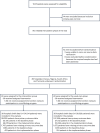A cost-effectiveness analysis of early detection and bundled treatment of postpartum hemorrhage alongside the E-MOTIVE trial
- PMID: 38844798
- PMCID: PMC11333277
- DOI: 10.1038/s41591-024-03069-5
A cost-effectiveness analysis of early detection and bundled treatment of postpartum hemorrhage alongside the E-MOTIVE trial
Abstract
Timely detection and treatment of postpartum hemorrhage (PPH) are crucial to prevent complications or death. A calibrated blood-collection drape can help provide objective, accurate and early diagnosis of PPH, and a treatment bundle can address delays or inconsistencies in the use of effective interventions. Here we conducted an economic evaluation alongside the E-MOTIVE trial, an international, parallel cluster-randomized trial with a baseline control phase involving 210,132 women undergoing vaginal delivery across 78 secondary-level hospitals in Kenya, Nigeria, South Africa and Tanzania. We aimed to assess the cost-effectiveness of the E-MOTIVE intervention, which included a calibrated blood-collection drape for early detection of PPH and a bundle of first-response treatments (uterine massage, oxytocic drugs, tranexamic acid, intravenous fluids, examination and escalation), compared with usual care. We used multilevel modeling to estimate incremental cost-effectiveness ratios from the perspective of the public healthcare system for outcomes of cost per severe PPH (blood loss ≥1,000 ml) avoided and cost per disability-adjusted life-year averted. Our findings suggest that the use of a calibrated blood-collection drape for early detection of PPH and bundled first-response treatment is cost-effective and should be perceived by decision-makers as a worthwhile use of healthcare budgets. ClinicalTrials.gov identifier: NCT04341662 .
© 2024. The Author(s).
Conflict of interest statement
G.J.H. has consulted for Equalize Health, a not-for-profit health technology company. This did not influence the design, conduct or reporting of the research presented in this manuscript. The other authors declare no competing interests.
Figures




References
Publication types
MeSH terms
Substances
Associated data
Grants and funding
LinkOut - more resources
Full Text Sources
Medical

